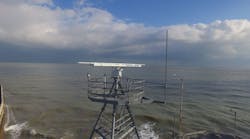When radar systems are needed for civil applications, such as for coastal surveillance or vessel traffic service (VTS) use, a decision on operating frequency can be difficult. Higher-frequency X-band radars (about 8 to 12 GHz) offer good detection resolution and the capabilities to extract information about a desired target from “clutter” caused by reflections from objects surrounding the target. On the other hand, they tend to lose range and performance due to water attenuation during rainfall. Lower-frequency S-band radars (about 2 to 4 GHz) lack the resolution and clutter resistance of higher-frequency radar systems, but they can detect targets across greater distances than higher-frequency systems and are relatively immune to the effects of rainfall.
Typically, a choice between the two types of radar systems involves balancing tradeoffs. That is, unless one specifies the SBS-900-4 SharpEye radar system from Kelvin Hughes. It provides both radars in one package, with co-located antennas and antenna turning mechanism that can transmit/receive both frequency ranges.
Both SBS-900-4 SharpEye radar transceivers are enclosed in a common mast-mounted housing. The antenna combination includes a 3.9-m S-band antenna and a 5.5-m X-band antenna (see photo). The compact, light-weight mechanical configuration helps prevent radar “ducting” that can occur with some mast-mounted systems. Ducting is essentially a refraction of the radar beam away from the antenna, causing the beam to bend back toward the earth rather than in the direction of the target area. The small size and light weight of the SBS-900-4 dual-frequency radar system allows installation at a higher elevation to increase the radar horizon and minimize the potential for ducting.
The dual-frequency radar system employs radar transceivers optimized for their bands of interest. The X-band transceiver uses Doppler, frequency diversity (FD), and pulse-compression techniques for accurate detection and high resolution. The S-band transceiver also uses Doppler moving-target-detection (MTD) techniques and high-resolution pulse compression techniques. The X-band antenna is mounted on top of the S-band antenna, 180 deg. from each other. The co-located antennas simultaneously transmit signals at both frequency bands.

